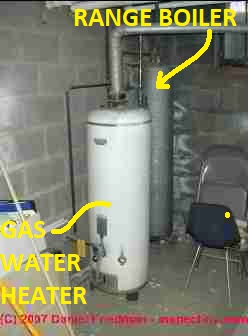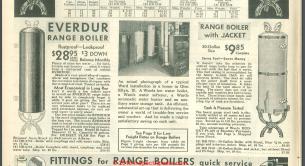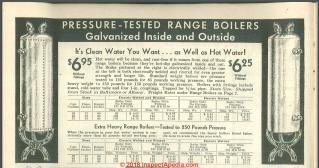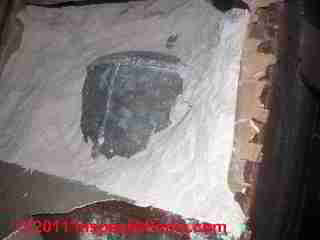 Guide to Range Boiler Water Heaters for Making Domestic Hot Water
Guide to Range Boiler Water Heaters for Making Domestic Hot Water
- POST a QUESTION or COMMENT about installing, using, & repairing range boilers used for hot water supply in buildings
Range Boilers for making domestic hot water:
In this article we define range boilers, and we explain the operation of range boilers used for making domestic hot water for washing and bathing.
We provide photos and sketches as well as text to help identify the types of tanks found inside old buildings.
InspectAPedia tolerates no conflicts of interest. We have no relationship with advertisers, products, or services discussed at this website.
- Daniel Friedman, Publisher/Editor/Author - See WHO ARE WE?
How a Range Boiler Makes Domestic Hot Water from a Heating Boiler
 A range boiler is an older type of domestic hot water heater which uses a separate hot water tank which is connected to a heating boiler as well as to domestic hot water piping in the home.
A range boiler is an older type of domestic hot water heater which uses a separate hot water tank which is connected to a heating boiler as well as to domestic hot water piping in the home.
Thanks to Carson Dunlop Associates, a Toronto Home Inspection Firm and Home Inspection Educator, for permission to use sketches shown in this article.
Below we describe some alternative ways to make hot water, either to replace or to supplement an existing hot water supply system. After knowing what the hot water problem really is, there are steps we can take to get more hot water or to increase hot water pressure.
Our page top photo shows a silver steel range boiler hiding back in the corner behind the newer (though pretty old) gas fired water heater. Notice also the efflorescence on the masonry block foundation, where the downspout has been spilling by the house foundation?
How does a Range Boiler Work?
Water circulates from inside the range boiler tank through a heat-exchanger coil that may be inside the heating boiler or it may be external, such as
Heat inside of the physically separate heating boiler warms water that circulates, usually by gravity (or convection) between the range boiler and the heating boiler.
Modern indirect-fired water heaters use the same principle as the range boiler but add heat controls and a circulator pump, as we discuss in detail
at Indirect-fired Water Heaters.
In our photo at page top you can see the old galvanized steel range boiler in the far corner of the basement. A newer (but still quite old) gas fired water heater has been installed in front of our old range boiler.
See WATER HEATERS for details about conventional direct-heated residential hot water systems.
Plumbing Connections for a Range Boiler
 You'll find at least four pipes connected to a range boiler tank, possibly five if the tank uses an overflow line in an attic instead of a pressure relief valve.
You'll find at least four pipes connected to a range boiler tank, possibly five if the tank uses an overflow line in an attic instead of a pressure relief valve.
Don't do what we did early in our HVAC career: some of those many connections on the range boiler seemed to have no purpose so we eliminated and capped off a pipe that seemed unnecessary. It was a mistake. All four pipes which we describe here are needed:
- Cold water into the water tank, coming from the building water supply. Cold water would typically enter at the bottom of the tank.
- Hot water leaving the water tank headed for plumbing fixtures. Hot water would leave from the top of the tank.
- A gravity line from near the bottom of the range boiler heater which by gravity permits cooler, heavier water in the tank to flow into a loop of heating pipe or into
a SIDE ARM COIL
which heats the water. Cold water would flow from tank bottom down to the heating location. - Hotter water rises by convection or "gravity" and flows back to the range boiler water tank.
In their earliest use range boilers were heated by a coal or wood stove as we show above.
In a later design range boilers may have included their own little gas or coal heater as we show in the sketch at left.
Later the same design was used in combination with a side arm coil to heat water in the range boiler tank using a coal or oil or gas fired heating boiler.
Range Boiler Operating Characteristics
Range boilers can provide a large volume of hot water, depending on the tank size. But they have a slow recovery rate once the hot water from the range boiler tank has been consumed.
It would be unusual to find a range boiler installed as new equipment in a modern building.
 Range boilers are vertical or horizontal hot water systems whose water is heated by circulating the water from within
a water storage tank (the range boiler) through a heat exchanger which is inside or connected to the exterior of a heating boiler.
Range boilers are vertical or horizontal hot water systems whose water is heated by circulating the water from within
a water storage tank (the range boiler) through a heat exchanger which is inside or connected to the exterior of a heating boiler.
The water in the hot water tank range boiler is heated by circulating its water through the heat exchanger which itself is heated by the water inside or from the heating boiler.
Illustrations: excerpts from a 1935 Montgomery Ward catalog illustrating four version of range boilers used to provide domestic hot water. [Click to enlarge any image]
As homeowners shifted fuels from coal to oil or gas and installed central heating boilers, often the range boiler water heater was adapted to work with these systems as well, as you can see in the photograph.
As with the indirect-fired boiler described next, range boiler water heating tanks are usually located close to the heating boiler and will have both cold and hot water lines leaving the tank to supply the building with domestic hot water and a loop of piping that runs between the bottom of the hot water tank and a nearby heating boiler.
Follow the pipes to see which pipes are performing which function.
The regulation of hot water temperature when using a range boiler water heater is discussed
at RANGE BOILER HOT WATER TEMPERATURE CONTROL
and
INDIRECT WATER HEATERS is in the details.
The heat exchanger that heats water in the range boiler is in or at the heating boiler.
The water in an indirect fired water heater such as the SuperStorTM unit is heated by a finned copper coil located inside the hot water tank.
The internal coil is in turn heated by circulating water inside the coil to and from the heating boiler. The range boiler is an old concept in use for about 100 years. Indirect fired water heaters are a modern system and are in current sales and use.
Because you might also encounter other smaller steel tanks connected to hot water heating boilers and found in building basements or attics
see EXPANSION TANKS
for a guide to these tanks that absorb pressure increases on hot water heating systems.
CONTACT us with comments about this attic tank.
More examples of water heaters and other mechanical equipment from the 1930's are in this large PDF file:
MONTGOMERY WARD COMPLETE CATALOG of PLUMBING HEATING BUILDING MATERIALS [PDF] (1935), retrieved 2018/02/23, original source: https://ia801600.us.archive.org/7/items/WardsCompleteCatalogOfPlumbingHeatingBuildingMaterials/WardsCompleteCatalogOfPlumbingHeatingBuildingMaterials.pdf
Range Boiler Safety
Unless the range boiler is vented to an overflow pipe like the attic tank in our discussion below, range boiler tank should be protected by a pressure/temperature relief valve just as any pressurized tank. If none is installed your range boiler does not meet modern safety standards - it is unsafe, and a relief valve should be installed promptly.
See RELIEF VALVE, WATER HEATER for details.
The characteristics of various water heaters such as life expectancy, cost, safety, and capacity are discussed
at WATER HEATER PROBLEM DIAGNOSIS
and
WATER HEATER COMPARISONS, PROPERTIES
Ways to improve hot water quantity, pressure, and flow are discussed beginning
at HOT WATER IMPROVEMENTS and
continuing
at HOT WATER QUANTITY IMPROVEMENT.
attic Range Boiler & Other Attic Water Tanks:
Photos, Pipes, Insulation, & Measurements Help Identify a Large, Antique, Insulated Steel Tank Found in an Attic: a Solar Water Heater
Question: Can You Identify This Old Tank in the Attic of our 1917 Home?
My wife and I purchased our 1917 home in downtown Riverside, California in 1984. In a few more years this house will be 100 years old.
To celebrate its coming birthday, I have started working on a small book about the history of the house.
When we bought the house we were told we were only the third owners, and the women we bought the house from (in her nineties) had her daughter (in her seventies) sell it to us.
The daughter told us her parents lived in the house for over fifty years and that they had not really done much to the house over all those years.

This is an attic storage tank probably used for a solar water heater system. Details are
at SOLAR WATER HEATER ANTIQUE - separate article
These Clues Can Identify the Original Use of Attic Tanks or Other Water Tanks Found in Older Homes
Take a look at and record the following information about an unidentified attic storage tank
- Tank size, dimensions, material; attic expansion tanks are smaller while water storage of any type, cisterns or water heaters, are larger
- Tank insulation: expansion tanks and cisterns are not insulated; water heater tanks may be insulated
- Tank location: a range boiler will be located close to the prime heating boiler; it would be unusual to locate a range boiler distant from the wood, coal, oil or gas fired heating boiler; an attic solar hot water storage tank is or was probably connected top a nearby rooftop or exterior wall-mounted solar collector.
- Tank piping: a water heater and hot water storage tank designed as a solar water heater or range boiler will typically have four pipe connections:
Water heating piping: Two lines run to and from the water heating source, possibly circulating by convection with cold water leaving the tank bottom and warm or hot water entering higher on the tank;
Hot water supply piping: Two other lines will feed cold water supply into the storage tank and hot water out of the storage tank headed for building plumbing fixtures.
How to Identify Heating Boiler Expansion Tanks in Attics
It looks from the partial exposure as if the tank is in a location where people used to put expansion tanks on hot water heating boilers - instead of a relief valve, if pressure in the system got too high, water would push into the tank and if the tank got too full, water would flow out of a drain into an outdoor location, sometimes even a roof gutter or downspout.
But based on its piping connections shown
we will see that this tank is something else. Usually an expansion tank has just one inlet pipe that feeds water from the hot water heating system, and for attic-located expansion tanks, an overflow drain line
...
Reader Comments, Questions & Answers About The Article Above
Below you will find questions and answers previously posted on this page at its page bottom reader comment box.
Reader Q&A - also see RECOMMENDED ARTICLES & FAQs
Questions & comments about range boilers:
(Nov 5, 2012) mat68046 said:
I suspect this both a hot water storage vessel from a range boiler and an indirect water heater-although the heat source in this case is from the flue that the tank seems to be encased with. By convection this tank may be heating static water before it is goes to domestic hot supply as a buffer for the boiler, to avoid cold start hot domestic. Definitely verify the potential asbestos hazard before disturbing that tank any more.
(Sept 27, 2014) Anonymous said:
I have a very old Range boiler. Maybe 20,s and what waere the common make ups of the actual metal of the tank. This seems to be galvanized as it has magnatized properties.
(Nov 12, 2014) james said:
I have I believe the old range tank boiler system over head tank in basement rafters. I am wondering if an indirect water heater can be added to increase the efficiency of this older design or system. For both domestic hot water and heating as well since they have their own recirculation pump. When the desire for heat comes from the thermostat instead of the boiler kicking on water from the indirect water heater is circulated until the temperature drops below a set point temperature.
Thus the furnace doesn't need to cycle on as often and therefore lower fuel or energy costs and consumption. I know probably not but if it is I know a lot of people that live in older colder climate homes that would also be interested. And this would be useful in any hydronic heating system oil, gas, or electric. The other good thing no added or minimal electric output in an older home slotted for rewiring from older wiring systems. And unhooking the electric water heater. The basic idea is like brewing a pot of coffee and pouring it into a Thermous jug for later use instead of leaving the coffee pot on all day.
Reply:
James
typically you can add an indirect water heater - it acts as an additional heating zone. You might want to abandon the range boiler in that event.
...
Continue reading at INDIRECT FIRED WATER HEATERS or select a topic from the closely-related articles below, or see the complete ARTICLE INDEX.
Or see these
Recommended Articles
- ATTIC & ANTIQUE EXPANSION TANKS, HEATING used with some older hot water heating systems.
- IDENTIFY WATER TANK USE
- INDIRECT FIRED WATER HEATERS
- RANGE BOILER HOT WATER TEMPERATURE CONTROL
- SOLAR WATER HEATER ANTIQUE
- WATER HEATERS - home
- WATER HEATER AGE & MANUALS
- WATER HEATER TEMPERATURE ADJUSTMENT CONTROLS
Suggested citation for this web page
RANGE BOILERS at InspectApedia.com - online encyclopedia of building & environmental inspection, testing, diagnosis, repair, & problem prevention advice.
Or see this
INDEX to RELATED ARTICLES: ARTICLE INDEX to WATER HEATERS
Or use the SEARCH BOX found below to Ask a Question or Search InspectApedia
Ask a Question or Search InspectApedia
Try the search box just below, or if you prefer, post a question or comment in the Comments box below and we will respond promptly.
Search the InspectApedia website
Note: appearance of your Comment below may be delayed: if your comment contains an image, photograph, web link, or text that looks to the software as if it might be a web link, your posting will appear after it has been approved by a moderator. Apologies for the delay.
Only one image can be added per comment but you can post as many comments, and therefore images, as you like.
You will not receive a notification when a response to your question has been posted.
Please bookmark this page to make it easy for you to check back for our response.
IF above you see "Comment Form is loading comments..." then COMMENT BOX - countable.ca / bawkbox.com IS NOT WORKING.
In any case you are welcome to send an email directly to us at InspectApedia.com at editor@inspectApedia.com
We'll reply to you directly. Please help us help you by noting, in your email, the URL of the InspectApedia page where you wanted to comment.
Citations & References
In addition to any citations in the article above, a full list is available on request.
- Mark Cramer Inspection Services Mark Cramer, Tampa Florida, Mr. Cramer is a past president of ASHI, the American Society of Home Inspectors and is a Florida home inspector and home inspection educator. Mr. Cramer serves on the ASHI Home Inspection Standards. Contact Mark Cramer at: 727-595-4211 mark@BestTampaInspector.com
- John Cranor [Website: /www.house-whisperer.com ] is an ASHI member and a home inspector (The House Whisperer) is located in Glen Allen, VA 23060. He is also a contributor to InspectApedia.com in several technical areas such as plumbing and appliances (dryer vents). Contact Mr. Cranor at 804-873-8534 or by Email: johncranor@verizon.net
- Ken Butti and John Perlin, A Golden Thread: 2500 Years of Solar Architecture and Technology, Cheshire Books, June 1980, ISBN-10: 0442240058, ISBN-13: 978-0442240059
- John Perlin & Amory Lovins, Let It Shine: The 6000-Year Story of Solar Energy, New World Library, Rev. 2013, ISBN-10: 1608681327, ISBN-13: 978-1608681327, Mr. Perlin can be reached at Tel: 805.569 2740, Email: jp@john-perlin.com, Website: john-perlin.com
- In addition to citations & references found in this article, see the research citations given at the end of the related articles found at our suggested
CONTINUE READING or RECOMMENDED ARTICLES.
- Carson, Dunlop & Associates Ltd., 120 Carlton Street Suite 407, Toronto ON M5A 4K2. Tel: (416) 964-9415 1-800-268-7070 Email: info@carsondunlop.com. Alan Carson is a past president of ASHI, the American Society of Home Inspectors.
Thanks to Alan Carson and Bob Dunlop, for permission for InspectAPedia to use text excerpts from The HOME REFERENCE BOOK - the Encyclopedia of Homes and to use illustrations from The ILLUSTRATED HOME .
Carson Dunlop Associates provides extensive home inspection education and report writing material. In gratitude we provide links to tsome Carson Dunlop Associates products and services.



